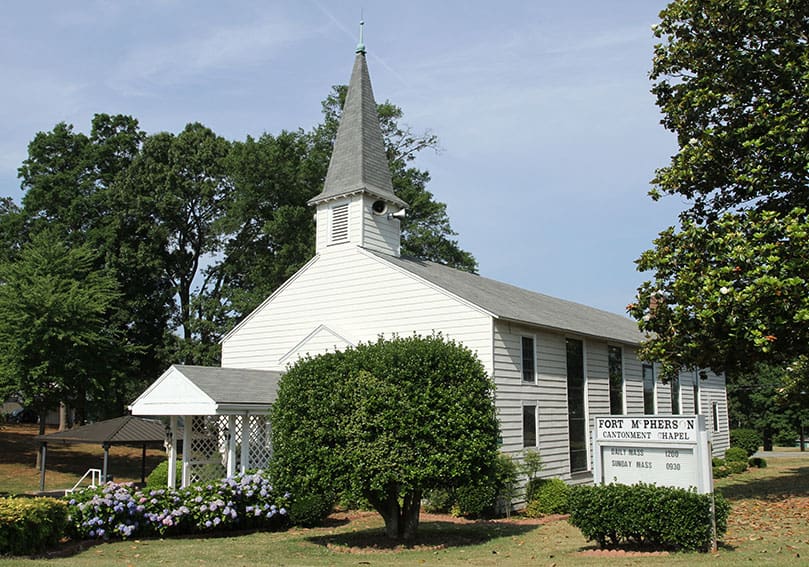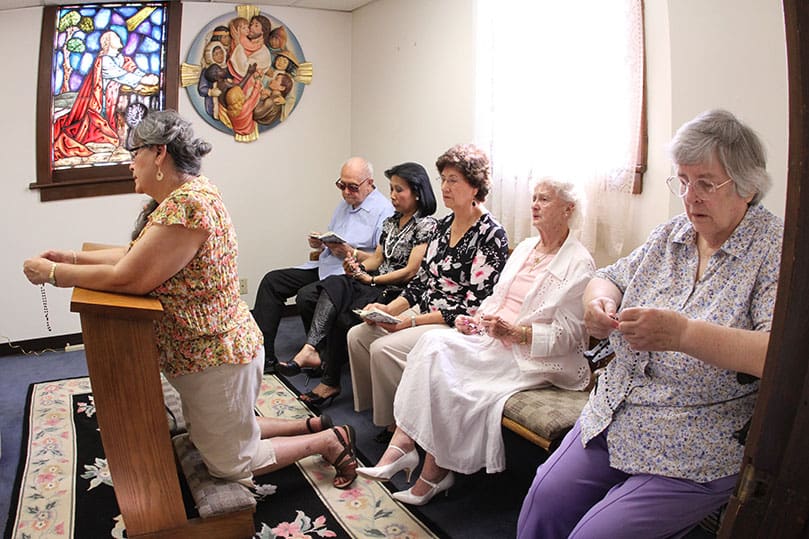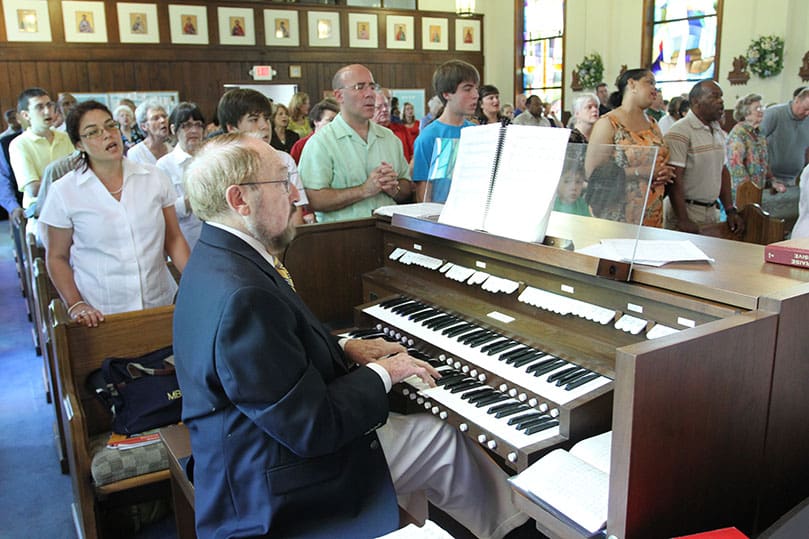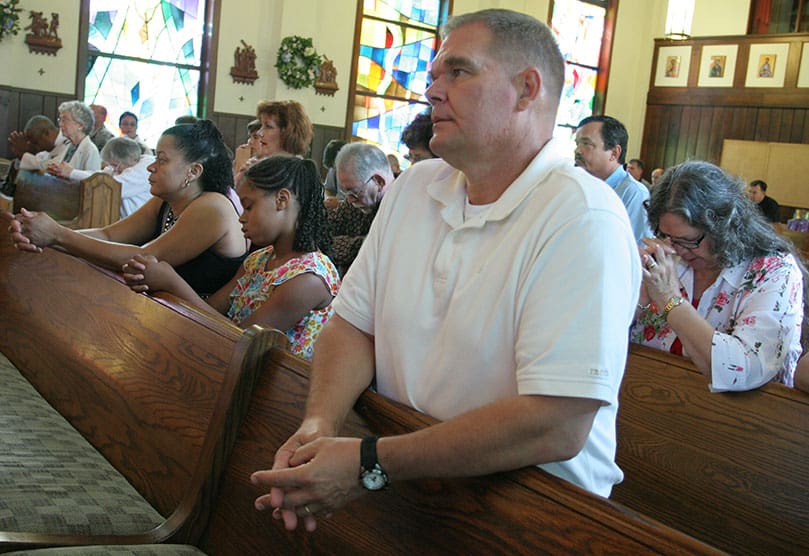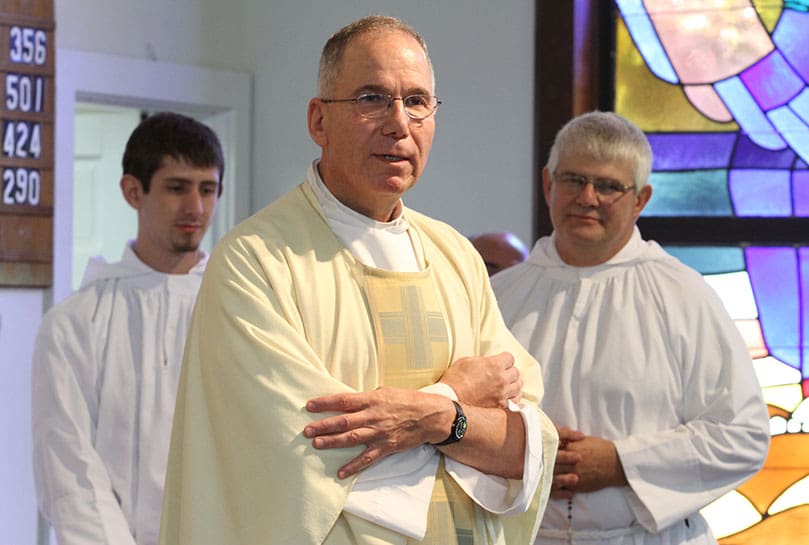The chapel was originally constructed in 1941 as a reception center for new Army recruits. Seventeen years later it was exclusively used as a place of worship for Catholics up until its decommissioning service, June 7. Photo By Michael Alexander
Atlanta
Base Chapel Closing A Loss For Military Families
By ANDREW NELSON, Staff Writer | Published June 23, 2011
Seventy years of history ended at Cantonment Chapel as Father Fred Wendel closed the front door of the small, white Catholic chapel at Fort McPherson.
During the closing ceremony June 7, Father Wendel, an Army chaplain, stopped briefly at the reconciliation room, the twelfth Station of the Cross, parts of the church important to Catholic spiritual life. From the baptismal font in the entryway to the statue of Mary near the front pew, he gave a prayer of thanks.
Standing in front of the doors of the chapel for the last time, Father Wendel said, “Although the service of the chapel has come to an end, we pray that you keep us ever mindful that wherever two or three are gathered in your name, your holy presence will be known. Accompany us as we move to new sacred places and new gatherings of your holy people.”
Indeed, people are ready to move on, but the ending remained bittersweet.
“We know a lot of people. I feel a big sense of loss having to leave the community. We should try not to get so attached, but it happens,” said Lt. Col. Ressie Harris-Delgado.
The chapel closed because the 488-acre military facility is shutting down, part of national base closures approved in 2005. By September, it’s to be handed over to civilians. It was the first military installation in the Southeast when it opened in 1889. The post has served as a hospital during World Wars I and II, a POW camp, a training camp for the Civilian Conservation Corps.
Soldiers Put Down Roots At Military Chapel
On Sunday, June 5, some 60 people, military retirees and active duty, gathered for Mass. Some churchgoers dressed in camouflage, while others were in summer casual clothes. It was the last Sunday Mass at the chapel as couples who married here, children who received First Communion, and senior citizens with beloved spouses buried here looked around one more time.
“Just by being a soldier, they understand your lifestyle,” said Harris-Delgado about the military parish. An extended absence can mean a deployment and the faith community understands that and reaches out to families, she said.
In the military, a soldier can put down roots in a faith community at a new assignment when everything else is unknown.
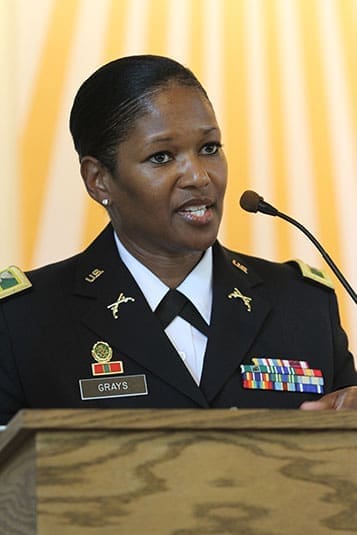
Col. Deborah B. Grays, Garrison Commander, shares some remarks with the congregation during the decommissioning of the Cantonment Chapel. Photo By Michael Alexander
When people pray for soldiers in harm’s way, folks know what that’s about. The Lund children were nervous when their father was deployed to Iraq twice. When they pray for other soldiers, it is heartfelt, said Col. Eric Lund. “Every one of us has done that,” he said.
With soldiers on the move every couple of years, friendships grow quickly among the people in the pews. Retired Maj. Charles Rickmond, whose late wife, Beatrice, was buried at the church, put it this way: “No one’s allowed to be a stranger.”
For Father Wendel, it closes a chapter, too. In his boyhood, his family worshipped at the chapel when they arrived at Fort McPherson in 1955.
“The chapel was packed. There were several Masses. Now we are down to 70 members,” he said. The small upper room was where he attended religious education classes.
“I can just imagine (my parents) saying, ‘Fred, you’ve lived quite a life,’” Father Wendel said. His voice broke with emotion talking about his parents and the chapel.
It was erected in 1941, when the post was a stopping point for recruits entering the Army during World War II. During its early years, soldiers gathered in the building for meetings, religious education classes and worship services for different faiths. In 1958, it became exclusively used for Catholic worship.
From the outside, it looks like a country church with a small steeple. Its interior has exposed metal girder trusses holding up the roof. In the 1980s, stained glass windows from the chaplain’s school at Fort Wadsworth in Staten Island, N.Y., were installed. Two windows were installed in the 1990s, done by the monks at the Monastery of the Holy Spirit, Conyers. The windows will remain with the building, but the rest of the religious icons are being distributed to other Catholic faith communities in the Army. Mass will continue to be celebrated on the base through July in the theater.
The McPherson Local Redevelopment Authority designed a plan to convert the base to a bioscience center to anchor future economic development. As part of the plan, the historic areas would be preserved and housing for a range of incomes would be created. The chapel is located in what would be a research and laboratory district. Nearby Fort Gillem, in Forest Park, will stay a military facility, but will become smaller, with fewer military detachments.
“Between The Years”
Military dignitaries at the June 7 decommissioning included Col. Deborah Grays, the garrison commander, and Lt. Col. Robert Phillips, the garrison chaplain.
Grays told the audience the building will close, but the history and countless people who worshipped within the walls of the building make up the most important memories.
History may mark a building’s opening and its close, but “what does matter is what occurs between the years and you are part of that history,” she said. “All that has been witnessed here is essential to the soul.”
Some families worshipped on the base and sent their children to nearby Catholic schools.

Laurens Hollis, the widow of a retired Army serviceman, was born and reared in College Park, so she has fond memories of Fort McPherson and the Cantonment Chapel. Hollis served as an extraordinary minister of Holy Communion for 25 years and at one time she headed up the Military Council of Catholic Women. Photo By Michael Alexander
The Delgado children—Leonardo and Charlotte—attended St. John the Evangelist School, Hapeville. The family worshipped here since 2006.
“For my kids, I feel a sense of loss for them,” Harris-Delgado said. The children will continue with their Catholic education in Fayetteville, N.C. Her husband, Roberto Delgado, retired from the Army.
The Lund family arrived here in the summer of 2009. They lived on the post so the chapel was a very short trip from home.
Finding a parish is one of the first things the Lund family does at a new assignment.
“You are going to miss it, sort of like you miss a family,” said Maria Lund. “There’s a bond that develops.”
And what made the chapel different was the mix of parishioners, with active duty military and retirees. “It is just fantastic. Their presence here just makes it richer,” she said about the retirees.
The family includes Mario, who was confirmed here, Ethen, Augustine, who received First Communion at the chapel, and Isaac.
Mario attended Our Lady of Mercy High School, Fayetteville, and Ethen and Augustine were students at St. John the Evangelist School. The boys plan on enrolling in Catholic schools in Raleigh, N.C., the family’s new assignment.
Father Wendel, who is a priest of the Atlanta Archdiocese, left on June 12 for Fort Jackson, S.C., to attend chaplain training. With the approval of Archbishop Wilton D. Gregory, he is serving in the Army for a second three-year term. There is great demand for Catholic priests in the military; with 350 slots reserved for priests, only 97 are filled, Father Wendel said.
The Cantonment Chapel community prepared for the closing day. At a celebration in February, some 200 people reminisced about the history. And in April, some three dozen people went on a retreat that focused on transition.
During the closing ceremony, a Eucharistic minister from St. John the Evangelist Church accepted a chalice of consecrated hosts to take to the nearby Hapeville parish. It symbolized the link between the closed chapel and the ongoing faith life celebrated by Catholics.
“Even though we are closing, we are part of the living Body of Christ,” Father Wendel said. “Let us leave with hearts full of thanksgiving.”
